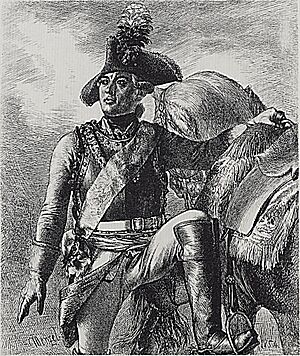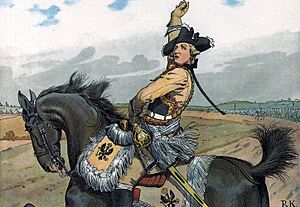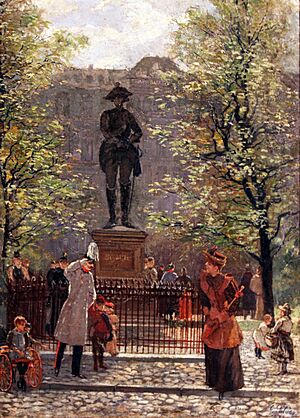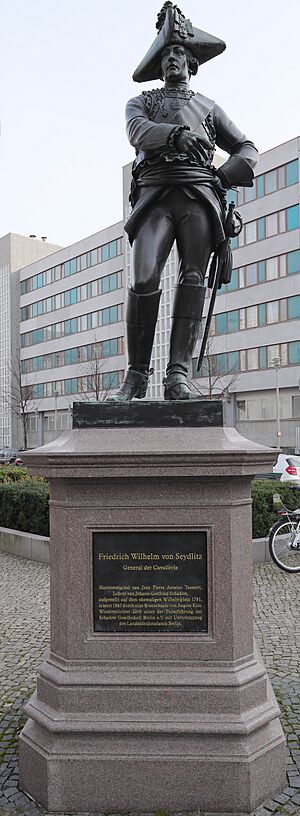Friedrich Wilhelm von Seydlitz facts for kids
Quick facts for kids
Generalleutnant
Friedrich Wilhelm von Seydlitz
|
|
|---|---|

Portrait by Adolph Menzel, 1854
|
|
| Born | 3 February 1721 Kalkar, Duchy of Clèves, Holy Roman Empire |
| Died | 8 November 1773 (aged 52) Ohlau, Silesia, Kingdom of Prussia, Holy Roman Empire |
| Allegiance | Kingdom of Prussia |
| Service/ |
Prussian Army |
| Years of service | 1739–1773 |
| Rank |
|
| Battles/wars | |
| Awards |
|
Friedrich Wilhelm Freiherr von Seydlitz (born February 3, 1721 – died November 8, 1773) was a famous Prussian general. He is known as one of the greatest cavalry leaders in history. He helped make the Prussian cavalry very strong and effective, especially during the Seven Years' War.
When he was young, Seydlitz was mentored by Margrave Frederick William of Brandenburg-Schwedt. He was an amazing horseman and very brave. He quickly became a skilled cavalry captain during the War of Austrian Succession.
During the Seven Years' War, Seydlitz became a legendary cavalry general. He was famous for his coup d'œil, which means he could quickly understand the whole battlefield. He was excellent at turning the King's orders into flexible plans. His cavalry played a key role in winning battles like Rossbach and Leuthen. Seydlitz was wounded several times in battle.
King Frederick the Great honored him with important awards, including the Order of the Black Eagle. Seydlitz died in 1773. His name is honored on the equestrian statue of Frederick the Great in Berlin.
Contents
Early Life and Horsemanship
Seydlitz was born on February 3, 1721, in Kalkar, a town in the Duchy of Cleves. His father, Daniel Florian von Seydlitz, was a major in the Prussian cavalry. When Seydlitz was seven, his father died, leaving his family with little money.
Even as a young boy, Seydlitz was a wild and energetic child. He could ride a horse very well. At age fourteen, he became a page, or servant, at the court of Margrave Frederick William of Brandenburg-Schwedt. The Margrave was a relative of the King and also loved daring horse stunts.
The Margrave inspired young Seydlitz to become an even better horseman. Many stories were told about Seydlitz's amazing riding skills. One famous story says he rode a horse between the moving sails of a windmill. On February 13, 1740, King Frederick William I of Prussia made Seydlitz a cornet (a low-ranking officer) in a cavalry regiment.
Start of a Military Career
Seydlitz's first months as a cornet were tough. His colonel treated him badly. But soon, King Frederick William died, and his son, Frederick II of Prussia, became King. Frederick wanted to claim Silesia from the Habsburg Empire, which led to war.
During the First Silesian War, Seydlitz showed his bravery. Once, the King asked about the size of enemy cannonballs. Seydlitz rode right in front of the enemy cannons, picked up a cannonball that landed, and brought it to the King.
In May 1742, Seydlitz and 30 men were ordered to hold a village. They faced heavy enemy fire, and no help came. Seydlitz and his small unit were forced to surrender and became prisoners of the Austrians.
Frederick later traded an Austrian captain to get Seydlitz back. When he returned, Seydlitz had a choice. He could wait for a promotion in a prestigious cuirassier regiment (heavy cavalry). Or he could immediately become a captain in a hussar unit (lighter cavalry). Hussars were new and less famous, but Seydlitz chose the immediate promotion. In 1743, he became a Rittmeister (captain) in the 4th Hussars, skipping the rank of lieutenant.
Seydlitz continued to serve in the Second Silesian War. He was praised for his actions at the Battle of Hohenfriedberg in June 1745. He even captured an enemy general himself. Because of his bravery, Frederick promoted him to major on July 28, when Seydlitz was only 24 years old. He also fought bravely at the Battle of Soor and Katholisch-Hennersdorf.
Developing Cavalry Tactics

After the war ended in 1748, Seydlitz focused on improving cavalry tactics. He created a plan for how the Prussian cavalry should train and fight. King Frederick approved his ideas. Seydlitz then started a very strict training program.
He demanded excellent horsemanship from all his soldiers. They had to be able to gallop across rough ground, turn in formation, and ride close together. They also had to be ready to support infantry or react quickly to the enemy.
Seydlitz taught his cavalry to use only their swords in battle. He believed pistols or carbines were not accurate enough and took too long to reload. He proved that soldiers could hit their target every time with a sword. The cavalry horses were strong Trakehners, bred in East Prussia.
On September 21, 1752, after a successful review of his cavalry, Seydlitz was promoted to lieutenant colonel. He became the commander-in-chief of all cavalry. In 1755, Frederick promoted him to colonel.
By the start of the Seven Years' War, Seydlitz's cavalry was Frederick's favorite. They were incredibly well-trained and had high morale. Frederick trusted them completely, and they trusted Seydlitz. The King ordered that no Prussian cavalryman should ever let himself be attacked without fighting back. This made Seydlitz's cavalry very active and aggressive.
Key Battles of the Seven Years' War
In May 1757, Seydlitz bravely led his regiment forward at the Battle of Prague. At the Prussian defeat at Kolin in June 1757, he and his cavalry helped stop the Austrian pursuit. Two days later, the King promoted him to major general and gave him the Pour le Mérite award.
Seydlitz's ability to quickly understand a situation was clear after the Battle of Kolin. The Prussians had to retreat from Prague. Seydlitz and his squadrons were trapped in a town by the Austrians. He tricked the Austrians into thinking his troops were just looking for food. Then, his cavalry suddenly attacked the unprepared Austrians and escaped.
The Battle of Rossbach
On the morning of the Battle of Rossbach, Frederick put Seydlitz in charge of all the cavalry. This made some older generals upset, but Seydlitz was pleased. At Rossbach, Seydlitz's quick thinking and understanding of the King's goals led to a huge victory.
He positioned his cavalry in two lines. He watched the French army for a few minutes while smoking his pipe. His soldiers watched him closely. When he threw his pipe away, it was the signal: the first line of cavalry charged forward. They crashed into the French army's side, which was completely unprepared.
Usually, cavalry would charge once and then chase the fleeing enemy. But Seydlitz was not satisfied. He called his second group of squadrons for another charge. Then, he pulled all 38 squadrons back into a group of trees to regroup. Without waiting for new orders, Seydlitz sent the Prussian cavalry to charge a third time. This was a key moment in the battle.
Seydlitz's squadrons charged directly into the French soldiers. It was a huge wall of horses galloping side-by-side, with riders swinging their swords at full speed. By the end of the battle, only a small part of Frederick's army had fired a shot. Most of the victory was thanks to Seydlitz's 38 squadrons and the artillery.
That day, the Prussians captured 72 cannons, seven flags, and 21 standards. With about 3,500 horsemen and 20 cannons, the Prussian army defeated the combined armies of France and the Holy Roman Empire. The tactics used at Rossbach became famous in military history. That same night, the King gave Seydlitz the Order of the Black Eagle and promoted him to lieutenant general. Seydlitz was wounded during the battle and spent four months recovering.
Later Campaigns
Seydlitz rejoined the King in 1758. On August 25, at the Battle of Zorndorf, his cavalry again helped secure the victory. He led 36 squadrons into a large group of Russian cavalry and infantry, breaking their lines.
At the Prussian defeat at Kunersdorf on August 12, 1759, Seydlitz was severely wounded while trying to storm a hill held by the Russians. His 8th Cuirassiers regiment was one of the few that remained strong at the end of the battle. While recovering in Berlin, he helped organize the city's defense during an Austro-Russian attack in October 1760. Even though the Russians briefly occupied the city, Frederick later praised Seydlitz for his actions.
Seydlitz's health often kept him from the battlefield. He did not return to the front until 1761. He then commanded a part of Prince Henry's army, which included both infantry and cavalry. Some officers doubted his ability to lead infantry, as he had only served with cavalry. However, at Freiberg on October 29, 1762, his leadership of both infantry and cavalry decided the battle's outcome.
Later Life and Legacy
After the Seven Years' War ended in 1763, Seydlitz became the inspector general of the cavalry in Silesia. This is where Frederick sent his most promising officers for training. In 1767, Frederick promoted Seydlitz to general of cavalry.
Seydlitz's later years had some personal challenges. He had married Susannah Johanna Albertine Hacke in 1761, but their marriage was difficult. He had at least one daughter, possibly two. His daughters faced personal struggles in their lives.
Seydlitz's health had been getting worse for years. He died in Ohlau, Silesia, in November 1773.
Memorials
In 1851, Frederick William IV of Prussia, a relative of Frederick the Great, included Seydlitz's name on the Equestrian statue of Frederick the Great in Berlin. This statue honors those who helped build the Prussian state. Seydlitz is one of the four full-sized mounted figures on the statue, sharing a place of honor with other important generals.
A bronze sculpture of Seydlitz was also placed at Wilhelmplatz in Berlin. Several German warships have been named after him, including the battlecruiser SMS Seydlitz, launched in 1913, and the heavy cruiser Seydlitz, launched in 1939.
See also
 In Spanish: Federico Guillermo von Seydlitz para niños
In Spanish: Federico Guillermo von Seydlitz para niños



